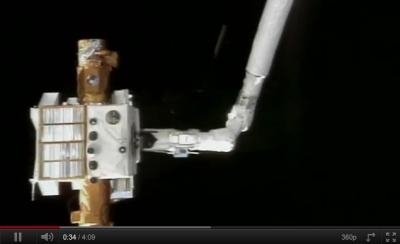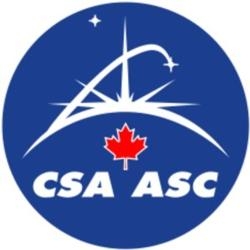Wed, Nov 09, 2011
Canadian Space Agency Salutes Three Decades Of Industry
Innovation
Canadarm, which many consider to be Canada's national icon of
technological innovation, made its space debut on the U.S. Space
Shuttle on November 13, 1981. Designed to deploy and retrieve space
payloads, the robotic arm quickly became a critical element in the
Space Shuttle Program. It worked flawlessly for 90 Shuttle
missions, spending a total of 944 days in space and travelling the
equivalent of over 387 million miles.

"It took incredible vision—and courage—to suggest an
element that would be both visible and critical to the Shuttle
program," said Steve MacLean, President of the Canadian Space
Agency (CSA). "The foresight of those early pioneers ended up
spawning decades of experience in on-orbit servicing for our
industry. The Canadarm became an enduring symbol of Canadian
ingenuity, and branded our country as a world leader in space-age
technology."
The CSA is working to ensure that the Canadarm, even on Earth,
continues to inspire future generations of Canadians. "We are
bringing Canadarm back to Canada," stated Steve MacLean. "Since it
was designed to work in the weightlessness of space and not on
Earth, the arm has to be modified for public display before it can
be installed at the CSA Headquarters. We will later evaluate
whether this national icon can be shared with Canadians in other
locations," explains MacLean.

Some of the Canadarm's most famous achievements include
retrieving the Hubble Space Telescope for repair, connecting the
two first modules of the International Space Station (ISS) and
inspecting the Shuttle's heat shield to ensure its safe return to
Earth. The design and construction of the Canadarm marked the
beginning of Canada's close collaboration with NASA in human space
flight, leading to the creation of Canada's corps of
astronauts.
While the Canadarm was retired after the Space Shuttle's final
flight in July 2011, the arm's legacy lives on through the suite of
Canadian robots on board the ISS, as well as the innovations in
robotic prototyping being done under the Next-Generation Canadarm
Program. The Canadarm has also inspired several generations of
scientists and engineers to develop new technologies for industry,
medicine, and other applications, such as neuroArm (an
ultra-precise robot for neurosurgery) and KidsArm for pediatric
surgery.
More News
Also: Vertical Flight Society, NBAA Maintenance Conference, GA Honored, AMT Scholarship For the first time, students from Embry-Riddle’s Daytona Beach, Florida, campus took t>[...]
Hazardous Weather Information Summary of significant meteorological information (SIGMET/WS), convective significant meteorological information (convective SIGMET/WST), urgent pilot>[...]
"The need for innovation at speed and scale is greater than ever. The X-62A VISTA is a crucial platform in our efforts to develop, test and integrate AI, as well as to establish AI>[...]
(FAA) Inspector Observed That Both Fuel Tanks Were Intact And That Only A Minimal Amount Of Fuel Remained In Each Analysis: According to the pilot, approximately 8 miles from the d>[...]
“Pyka’s Pelican Cargo is unlike any other UAS solution on the market for contested logistics. We assessed a number of leading capabilities and concluded that the Pelica>[...]
 Airborne-Flight Training 05.09.24: ERAU at AIAA, LIFT Diamond Buy, Epic A&P
Airborne-Flight Training 05.09.24: ERAU at AIAA, LIFT Diamond Buy, Epic A&P ANN's Daily Aero-Term (05.07.24): Hazardous Weather Information
ANN's Daily Aero-Term (05.07.24): Hazardous Weather Information Aero-News: Quote of the Day (05.07.24)
Aero-News: Quote of the Day (05.07.24) NTSB Final Report: Cessna 150
NTSB Final Report: Cessna 150 Aero-News: Quote of the Day (05.08.24)
Aero-News: Quote of the Day (05.08.24)




